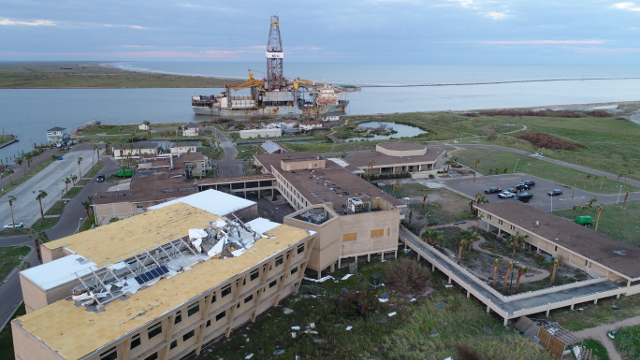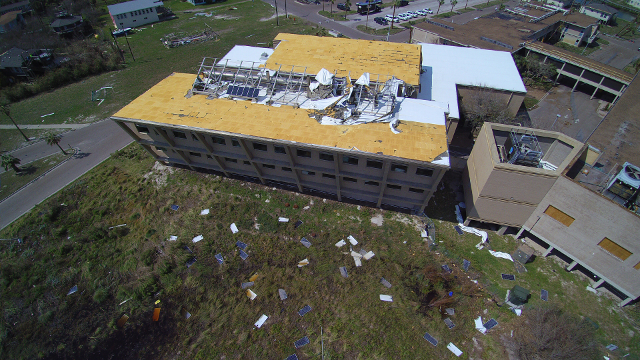 Damage from Hurricane Harvey to the main campus of the Marine Science Institute. In the background is the drilling rig (since removed) that smashed a research pier.THE UNIVERSITY OF TEXAS MARINE SCIENCE INSTITUTEWhen Edward Buskey of the Marine Science Institute (MSI) at the University of Texas and his team got the word on a Thursday morning in late August that the storm barreling toward them had been upgraded to a Category 3 hurricane (it would later reach Category 4), they had just four or five hours to secure their instruments and equipment before evacuating. “We did a good job of it, but basically everybody was going in different directions,” he says.
Damage from Hurricane Harvey to the main campus of the Marine Science Institute. In the background is the drilling rig (since removed) that smashed a research pier.THE UNIVERSITY OF TEXAS MARINE SCIENCE INSTITUTEWhen Edward Buskey of the Marine Science Institute (MSI) at the University of Texas and his team got the word on a Thursday morning in late August that the storm barreling toward them had been upgraded to a Category 3 hurricane (it would later reach Category 4), they had just four or five hours to secure their instruments and equipment before evacuating. “We did a good job of it, but basically everybody was going in different directions,” he says.
The scramble to flee the impending storm was a wise one. MSI’s campus in Port Aransas is located partly on an island in the Gulf of Mexico, and was vulnerable to flooding from a storm surge....
Three weeks on, his team is still assessing the damage done, including the loss of at least one of its five water quality monitoring stations in the nearby estuary, and heavy damage to a rehabilitation keep for injured wildlife, such as sea turtles and birds (the animals had been moved to safety ahead of the storm).
A weather station on a research pier had continued to record data as the eye of the storm passed over MSI, only to be smashed two days later by a drifting oil drilling ship. But for Buskey, whose projects include studying the effects of oil droplets from the Deepwater Horizon spill and who is now set up temporarily at Texas A&M Corpus Christi, one of the biggest concerns is keeping track of those things that haven’t been lost.
See “Labs in Texas Batten Down the Hatches”
“That’s one of the things that worries me the most, is that I knew where everything was in my lab and the office before, and now everything’s just been stuffed into boxes and some of it’s been moved over here,” to Texas A&M, he says. “I wonder how long it will be before I can figure out where all my stuff is and try to put the lab back the way it was before. That’s going to take some effort.”
MSI has 14 faculty members who study ocean and coastal ecosystems. In addition to its research, it manages the nearby Mission-Aransas National Estuarine Research Reserve and holds educational programs in dedicated buildings. Beyond its 72-acre main campus, which has laboratories, classrooms, dormitories, a cafeteria, and other facilities, MSI has a nearby Fisheries and Mariculture Laboratory where researchers study captive fish and crustaceans.
“It’s going to take months to get back to normal,” MSI’s director, Robert Dickey, tells The Scientist. Like Buskey, most of the institute’s faculty, staff, and students are now working and taking classes on the Texas A&M Corpus Christi campus, about 15 miles away, he says. He estimates it will take three to four months to make MSI’s on-site housing usable again, and at least six to eight months before those whose labs were damaged can move back in. The institute estimates the total storm damage at $104 million.
 The storm blew part of the roof off of MSI's headquarters building.THE UNIVERSITY OF TEXAS MARINE SCIENCE INSTITUTEWho foots the bill for the restoration is not yet clear. A spokesperson for MSI says the expectation is that the University of Texas will coordinate efforts to get funds from state and federal governments. Buskey says MSI also asked the National Oceanic and Atmospheric Administration (NOAA) for help replacing the estuary monitoring equipment, given that it’s a NOAA-funded project.
The storm blew part of the roof off of MSI's headquarters building.THE UNIVERSITY OF TEXAS MARINE SCIENCE INSTITUTEWho foots the bill for the restoration is not yet clear. A spokesperson for MSI says the expectation is that the University of Texas will coordinate efforts to get funds from state and federal governments. Buskey says MSI also asked the National Oceanic and Atmospheric Administration (NOAA) for help replacing the estuary monitoring equipment, given that it’s a NOAA-funded project.
See “Flooding in Texas Blocks Researchers from Campuses”
The losses include hundreds of fish used for research, casualties of the aeration and seawater intake systems going down, Dickey says. About 25 percent of MSI’s captive fish survived, including its broodstock. Part of the roof blew off the headquarters building and water came in, affecting labs, including that of microbial ecologist Brett Baker. Fortunately, Baker says, the equipment there was covered in plastic, but most of it is now in temporary storage, and he hasn’t had a chance yet to check whether it still works.
For Baker, the disruption to his work is just one of many things he’s had to cope with over the past few weeks. His family’s house flooded, so they’re now in a rental. His eight-year-old son’s school isn’t expected to reopen for four to six weeks, so he took the boy to Wisconsin to stay with his grandparents and attend school there for now. He tells The Scientist, “Today [September 12] was actually the first day since before the storm that I sat in front of my computer and was able to actually do some work, which felt really good.”
One of Baker’s graduate students will, like him, be based at Texas A&M Corpus Christi for the time being, while the other two are now at collaborators’ labs at the University of California, Berkeley, and Uppsala University in Sweden. Because most of his work involves genomics, he’s planning to focus on computation for the coming months rather than try to do bench work in his temporary digs. And he thinks the unexpected opportunity for his students to work with collaborators in person will be fruitful. “I think ultimately it’ll end up being really good, in that we’ll probably do some new things.”
Interested in reading more?





